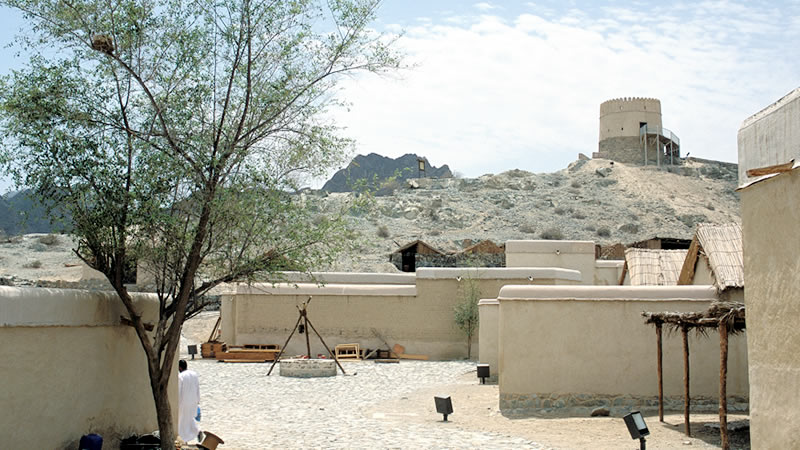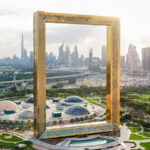
Introduction to Dubai’s Historic Sites Dubai, known for its towering skyscrapers like the Burj Khalifa and its luxurious lifestyle, is a city that has successfully combined modernity with its rich cultural heritage. While contemporary architecture and cutting-edge design dominate its skyline, the city also boasts a wealth of historical sites that provide a glimpse into its fascinating past. In this guide, we explore seven such heritage landmarks that showcase Dubai’s unique history and culture.
Explore the Dubai Museum at Al Fahidi Fort
The Al Fahidi Fort, Dubai’s oldest fort, was built in 1787 to defend the city from foreign invasions. Its square structure is made of coral rock and mortar, with cannons guarding its entrance and towers at three corners. The fort once served as the residence for the ruling family, as well as the seat of government, housing a garrison and a prison within its walls.
Today, the Al Fahidi Fort is home to the Dubai Museum, which opened in 1971 after extensive restoration. Visitors can explore the museum’s courtyard, which features a traditional palm-leaf house and an Emirati wind tower, as well as dhows or traditional boats. Inside, the museum showcases a range of weaponry, musical instruments, and exhibits that depict the city’s history, including ancient graves from the Al Qusais archaeological site.
Stroll through Al-Fahidi Quarter, also known as Bastakia Neighborhood
Adjacent to the Al Fahidi Fort is the picturesque Al-Fahidi Quarter, established in the late 19th century by wealthy Persian traders and merchants seeking tax-free trade opportunities. The charming neighborhood is characterized by its traditional architecture, including wind towers that served as early forms of air conditioning.
As you meander through the winding lanes, visit the Majlis Gallery, which houses vintage Arabian furniture and ceramics, and the Al Serkal Cultural Foundation, where you can view various art exhibitions.
Experience the Hatta Heritage Village
Nestled in the Al Hajar mountains, the Hatta Heritage Village is a restored traditional mountain village that showcases the UAE’s rural life before the oil boom. The village, which consists of around 30 houses and mosques built from mud, palm tree trunks, stones, fronds, and reeds, is managed by the Dubai Culture & Arts Authority and opened to the public in 2001.

Discover the Sheikh Saeed Al Maktoum House
This historical residence of Dubai’s former ruler, Sheikh Saeed Al Maktoum, was the site where he envisioned transforming Dubai into a global hotspot. Built in 1896 along Dubai Creek, the house is now a museum that offers a glimpse into the city’s past. Visitors can explore nine wings, which showcase old photographs, historic documents, and details about the Al Maktoum family lineage.
Admire the Jumeirah Mosque
Constructed in 1979 in the Fatimid style of Islamic architecture, the Jumeirah Mosque is a stunning landmark that closely resembles Cairo’s Al-Azhar Mosque. Managed by the Sheikh Mohammed Centre for Cultural Understanding (SMCCU), the mosque holds guided tours, lectures, meals, and classes to promote religious harmony and understanding of Islam.
Learn at the Al Ahmadiya School in Al Ras, Dubai
Established in 1912 as Dubai’s first semi-regular school, the Al Ahmadiya School operated until 1958 before being converted into a museum in 1994. Visitors can explore the school’s classrooms, curriculum, and facilities, gaining insight into the history of Dubai’s education system and the emirate’s long-standing commitment to education.

Unearth the Past at the Jumeirah Archaeological Site
Discovered in 1969, the Jumeirah Archaeological Site dates back to the Abbasid period of the 9th century AD. Managed by the Dubai Culture & Arts Authority, the site contains precious artifacts from this ancient era. Excavations have uncovered bronze coins, pottery, tools, decorative items, architectural remnants, a mosque, glass artifacts, stone items, and more. Historians believe the site, called Tawam, once covered 80,000 square meters and played a crucial role in the trade routes linking the region to India and China.
Conclusion
Dubai offers a rich tapestry of historical and modern experiences, with each site reflecting the city’s unique blend of the past and present. When planning your trip to Dubai, be sure to visit these seven extraordinary landmarks to fully appreciate the city’s captivating history and heritage.




